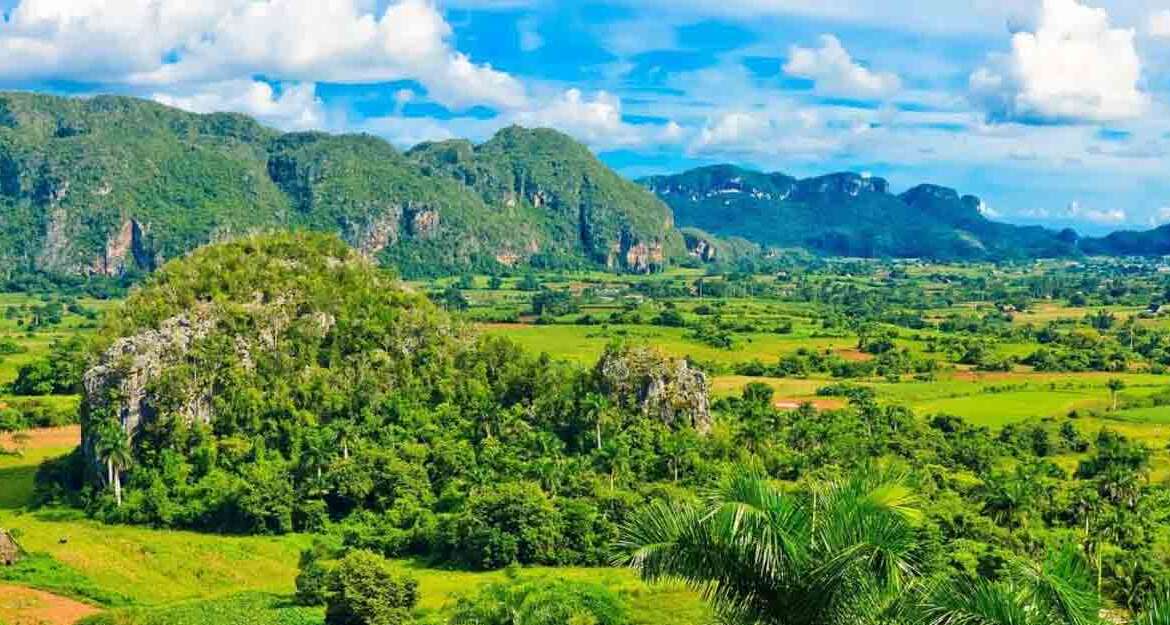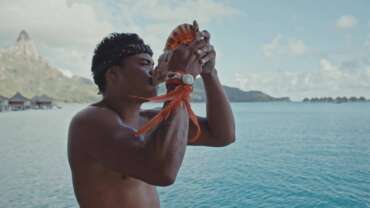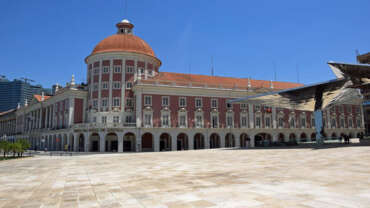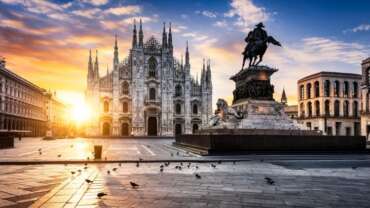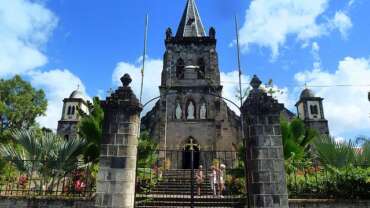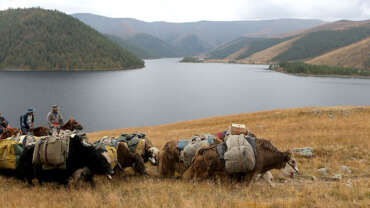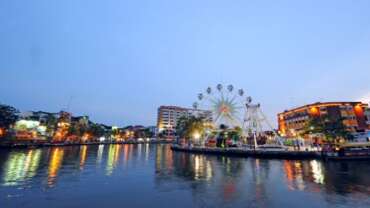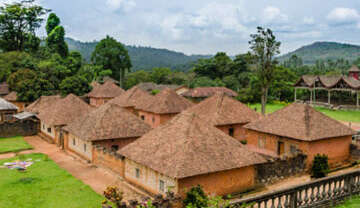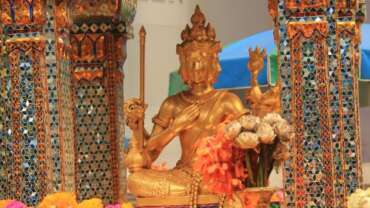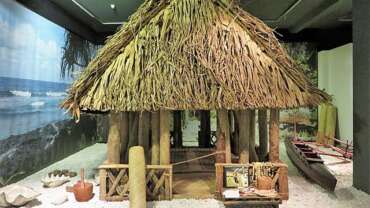Cuba - Your Safe Destination
Cuba is culture, nature, history, magic and traditions. The Pearl of the Antilles is the result of the blend of multiple cultures, fusion of races and customs that gave birth to one of the most unique and fascinating Caribbean destinations.
Your trips to Cuba will be characterized by its people. The Cubans are imaginative, joyful, unprejudiced, show their intelligence and are friends of joking and celebrating. And talking about celebrations, now that you’re here you won’t want to miss the carnivals, charangas, the parrandas, the countryside parties and the patron saint’s days, when you’ll have the chance of tasting the typical Cuban gastronomy made of Buñuelos, Tamales and Roasted Pork, always accompanied by a good coffee, a Cuba Libre, a Daiquiri, Mojito or Piña Colada drink.
The revolution marks a before and an after in the history of Cuba. The triumph of January 1st, 1959 meant a new beginning for Cuba and made its culture one of the most prolific ones in Latin America. Cuba excels at dancing, with the world-wide famous National Ballet of Cuba, in literature with authors like Jose Maria Heredia, Jose Marti, Jose Lezama Lima and Alejo Carpentier and practically in every single artistic manifestation, whether theatre, cinema or visual arts.
There are two ways to get to Cuba: by air and by sea. The island has 10 international airports and 15 national airports distributed throughout the archipelago; 4 cruise terminals and 15 international marinas complete the logistic infrastructure that eases tourism in Cuba.
History of Cuba
The history of Cuba is mainly divided into four periods. The first period where is included the primitive community or pre-Columbine. The colonial period (1492-1898) that encompasses since the Colombus’ arrival to the new world and the struggles for the national independence of Cuba. In this second period is included the Spaniard-Cuban-North America War and the military occupation of Cuba by United States (1899-1902). The third period encompasses the Neocolonial Republic since the installation of the New Republic in 1902 until 1958. The Revolution in Power period extends from 1959 until present day. The Triumph of the Cuban Revolution in 1959 marks a new stage in the Cuban’s history and society.
This division responds to the process of national formation, differentiating in its development the gestation period of nationality under Spanish colonialism. The third period that opens with the creation of the Cuban national state, although in a clear situation of dependence on the United States and finally, the Revolutionary Period, in which the nation reaches a fully sovereign existence.
First Settlers of Cuba
Valid is to remember that the population of Cuba had begun four millennia before the arrival of Columbus, with the arrival of diverse migratory currents. The admiral found on his arrival, along with the charms of exuberant nature, the presence of peaceful and naive settlers who offered him cotton, yarn and small pieces of gold in exchange for trinkets.
Then, after exploring the southern coast of Cuba during his second trip, he would realize the diversity of these indigenous people with different levels of sociocultural development. Hence, it was divided into the groups known as: Gatherers-Hunters-Fishermen and Farmers-Ceramists.
Encounter of Two Worlds
The conquest of the island by Spain began in 1510 with a prolonged operation of recognition and conquest, plagued by bloody incidents by Diego Velázquez. With the foundation of Our Lady of the Assumption of Baracoa, in 1512, the founding of six other founding Villas happened to him.
Mining and gold mining with indigenous labor through the so-called system of “parcels”, they will be replaced later by slave trade and slave labor as part of the plantation system.
The Colonial Cuba
Conquest and colonization characterized this period in the history of Cuba. In the midst of attacks by corsairs and pirates with the consequent reinforcement of the fleets system and the construction of various fortifications as a defense, economic activity grew and diversified with the development of livestock, the cultivation of tobacco and the production of sugar cane.
Slavery was an important source of social instability, not only because of the frequent manifestations of rebelliousness of slaves – both individual and in groups – but also because the repudiation of this institution gave rise to abolitionist conspiracies. Other ideological currents such as Reformism, Annexationism and independence movement joined it. All this led to the start of the independence fights on October 10, 1868, led by Carlos Manuel de Céspedes and a group of patriots at the Demajagua sugar mill..
The War of the Ten Years or Big War, culminated with the Pact of Zanjón, in 1878, which did not recognize the independence of Cuba or the abolition of slavery, the two essential objectives that had sustained the revolution.
Between 1879 and 1895, a period known as the Fertile Truce or Turbulent Rest, the figure of José Martí, National Hero of Cuba, who joined Cubans from inside and outside the Island to restart the struggle for independence, was highlighted..
On February 24, 1895, the colonial conflict led by Martí was resumed, and Generals Máximo Gómez and Antonio Maceo. After two years of intense struggle, the government of the United States intervenes without recognizing the organs of revolutionary leadership of the Cubans. On December 10, 1898, the Treaty of Paris was signed, which put an end to Spanish colonialism in Cuba. The Island ceased to be the jurisdiction of Spain and was being occupied militarily by the United States.
The Republic
The struggle for Cuba’s independence continues in the scenario of puppet governments, dictatorships, strikes, uprisings, reforms, clandestine struggle, assaults on barracks, battles in cities and mountains carried out by recognized student and labor leaders..
A trial, that of Moncada, a plea that would become a Programmatic Platform to follow, a Movement, that of July 26 and a generation, that of the centenary, gave rise to the insurrectional struggle against the dictatorship of Fulgencio Batista, to the second invasion from East to West and with it at last the desired triumph in January 1959.
The Cuban Revolution
The triumphant Revolution in power and power emanating from the whole people. Necessary reforms, fight against bandits, mercenary invasion expired in less than 72 hours, multiple attacks, and an energetic town that defends its conquests with the force of ideas. On the basis of humanism and practicing Internationalism, always advocating for equity and social justice.
Nature of Cuba
The nature of Cuba is rich and curious in all its extension. The Flora distinguishes by the endemic and diversity of its plant communities. Of all this groups, the orchids, cacti and palms are the highlighted ones. The fauna of Cuba has the peculiarity of having in the smallest its most exclusive features, and in the 368 different bird species, the reptiles and amphibians, the exclusivity has high percentage. This richness and endemism are endless. The marine ambiance and wetlands, living fossil, endangered species and important coral reefs have a great value and international acknowledgments.
The Island has a rich and varied terrestrial fauna. There are species that are internationally recognized as its dwarfism. For example, the World’s Smallest Bird: zunzuncito (fly bird, Cuban bee hummingbird or Helena hummingbird (Mellisuga helenae), a true winged jewel (63 mm in length).
It is also worth mentioning the Cuban frog (Eleutherodactylus limbatus) (12 mm in length); the butterfly bat that weighs 2 to 3 grams, and a dwarf scorpion (10 mm in length); In addition, there are numerous species of mollusks, some of a great beauty such as polymitas; there are considered by many experts as the most beautiful land snail.
The land and marine avifauna is diverse and attractive and consists of more than 350 species reported (many of which are endemic). There are species that migrate to the island in the winter. The privileged geographical position, halfway between the two Americas, makes Cuba a place for a large number of birds. For this reason, there are internationally recognized areas, such as the Ciénaga de Zapata (Zapata Swamp).
For the visitors that are looking to be in direct contact with nature there are many options: bird watching, hiking, diving, sport fishing, outdoor horseback riding, cave tourism, bicycle tourism or rural tourism are some of the options in Cuba.
Protected Areas in Cuba
Occidental Region
• Guanahacabibes National Park
• Viñales National Park
• Mil Cumbres Protected Area of Managed Resources
• Sierra del Rosario Biosphere Reserve
• Las Terrazas
• Soroa
• Península de Zapata Biosphere Reserve
• Valle del Río Canímar Protected Natural Landscape
Central Region
• Guanaroca- Punta Gavilán Refuge of Fauna
• Hanabanilla Protected Natural Landscape
• Cayo Santa María Refuge of Fauna
• Las Loras Refuge of Fauna
• Caguanes National Parks
• Topes de Collantes Protected Natural Landscape
• Lomas de Banao Ecologic Reserve
• Jobo Rosado Protected Area of Managed Resources
• Sierra del Chorrillo Protected Area of Managed Resources
• Limones-Tuabaquey Ecologic Reserve
• Río Máximo Refuge of Fauna
• Other touristic areas of interest: Yaguanabo Protected Natural Landscape
• El Nicho
Oriental Region
• Desembarco del Granma National Park
• Turquino National Park
• Baconao Biosphere Reserve
• La Gran Piedra Protected Natural Landscape
• Hatibonico Ecologic Reserve
• Alejandro de Humboldt National Park
• El Yunque de Baracoa Featured Natural Element
Traditions and Customs in Cuba
The traditional Cuban parties by excellency are the carnivals, las charangas, las parrandas, peasant feasts and the patron saints. Among the most popular ones that can be mentioned are Bandos de Majagua, which takes part at the province of Ciego de Ávila; Carnivals of La Habana and in Santiago de Cuba; las Charangas of Bejucal, performed in the province of Mayabeque; las Romerías of May, celebrated in the city of Holguín; and las Parranda in the central region of Cuba Declared Cultural Patrimony of the Nation, are the ones of Remedios in Villa Clara, ones of the most famous.
Cuban Clothing
The Typical Cuban clothing are: the guayabera, for both daily use and gala use; the Cuban robe, a traditional female clothing is from the XIX century; and the yarey hat, the essential accessory for the rural Cuban and historically used by the mambises oh the Independence wars.
Cuban Gastronomy
The Cuban gastronomy is the result of the mix of Spanish, Africans, aboriginal, Yucateca and even Asian traditions. The most significant are the Ajiaco, Casabe, Buñuelos, Tamales, Tostones, roasted pork and the Congrí. The typical Cuban beverages are characterized by showing common elements with the creoles meals; because it counts with the hispanic, African, Arab, Yucateca, China mix. Their definitive features are associated to the tropical weather conditions and generally to the production of sugar cane.
Among the most representative, that have won international fame, are the coffee, the Champola, Guarapo, the oriental Pru, Cuba Libre, Daiquiri, Mojito and the Pina Colada.
Heritage of Humanity in Cuba
Cuba is one of the countries in the Caribbean that has more Intangible Cultural Heritages recognized by the UNESCO. More than 20 expressions and manifestations built the Cultural Heritage of the Nation, some peculiar as the Lecturas de Tabaquería and the Saberes de los Maestros Roneros.
Regarding music and dance, the following have been declared Cultural Heritage of the Cuban Nation: the repentismo, because of its indissolubly cultural value and because of the historic role that the poets played since the Independence war until today. The son, the most appreciated music genre, singed and danced through the history. The rumba as the more genuine music-dance community expression of the Cuban national culture, and that has become part of the popular conscience, a lifestyle, a social behavior, a way of speaking, communicating. The danzón is an expression of the traditional Cuban music and an immaterial highlighted element of the nation.
In Cuba you can find 10 places and cultural expressions, declared UNESCO World Heritage Sites:
Camagüey Urban Historic Center
Cienfuegos Urban Historic Center
French Tombs
Alejandro of Humboldt National Park
Archaeological Landscape of the Firsts Coffee Plantations in the Southeast of Cuba.
National Park of Landing of Granma
Valle de Viñales
Castle San Pedro of the Roca of Santiago de Cuba
Historic Center of Trinidad and its Valle de los Ingenios
Historic Center of La Habana Vieja and its system of Colonial Fortifications
The National Monuments of Cuba are more than 260 and are included in the classification of sites, constructions and historical objects. Likewise, you can find 317 museums of different themes, located on all the National Territory.
The Cuban
Cubans are imaginative, cheerful, unprejudiced. They show a clear and joyful intelligence. Cubans are friends with jokes and parties and always have a smile on their face. The Cubans are communicative and conversational, but also know how to live their private lives. They are hospitable, educated, and worthy. “Open to the world, joyful to know the new to adjust it to their creative imagination, united and grouper since the revolutions of the past century, loyal to their experience and historic identity”.
The traditional Cuban festivities par excellence are the carnivals, the charangas, the parrandas, the peasant parties and the patron saints.
The most popular are:
– Bandos de Majagua, in the province of Ciego de Ávila;
– Carnivals of Havana and those of Santiago de Cuba;
– Las Charangas de Bejucal, in the province of Mayabeque;
– The Romerías de Mayo, in the city of Holguín;
– The Parrandas de Remedios, in Villa Clara, declared National Cultural Heritage. It is one of the most famous.
Cultivation of Cuban Tobacco
The tobacco is one of the most representative products of Cuba’s economy. Its cultivation, mainly in the province of Pinar del Rio, takes a process of recollection, stripping and picking, manufacturing and storing properly supervised. The quality of the Cuban tobacco is world-wide known and the visitor finds in the designed routes a motivation to discover the secrets of this special process.
Cuban Rum
The Cuban rum also has its history. Flavor, texture and aroma blend to result in a drink that attracts many inside and out Cuban territory. It adopts many ways through its interesting process, but it is equally enjoyed, alone or as a part of those very unique drinks that are prepared through the island as a very welcomed companion.
Cuban Coffee
The cultivation of coffee also occupies a space in the economy of Cuba. From the coffee plantations originated by the French immigrants to our days, this aromatic drink so common among Cubans has a space of interest in their daily life. The mountains are usually the characteristic place where one can find these colorful fruits that embellish a whole branch in the bushes that cross the fields.
Religion in Cuba
Cuba is a Lay State and recognizes the right of the Cuban people to practice any religious creed. As its culture, Cuban Religion is a mixture where syncretism is present. The Hispanic and the African constitute the two main ethno cultural roots of Cuban nationality. It also gathers other cultures (Caribbean, North American, Chinese and the rest of Europe), with a complex process of transculturation and miscegenation. This works as an influence in the religious diversity and in the construction of multiple temples throughout the national territory. The Virgin of the Caridad del Cobre is the patroness of Cuba.
Cuban Typical Food
The Cuban typical dishes are the result of the mix of Spanish, Africans, aboriginal, Yucatecan and even Asian traditions. The most significant dishes are the Ajiaco, Casabe, Buñuelos, Tamales, Tostones, roasted pork and the Congrí. The typical Cuban drinks are characterized by showing common elements with the creoles meals, because they have the Hispanic, African, Arab, Yucatecan and Chinese mix. Their definitive features are associated to the tropical weather conditions and generally to the production of sugar cane.
Among the most representative drinks that have won international fame are the coffee, the Champola, Guarapo, the oriental Pru, Cuba Libre, Daiquiri, Mojito and the Piña Colada.
The Cuban Culture

The culture of Cuba is one of its biggest assets. Diverse and mixed, it takes part in the identity of the Cuban and in the construction of the nationality.
Over five centuries of history accumulated unmatched richness of oral tradition and artistic manifestation that, along with symbols, representative figures and diverse cultural spaces, make Cuba much more than just an island in the Caribbean.
Marked by varied influences, Cuba not only has the tobacco, the coffee and rum, but also tangible and intangible values that attract the visitors because of their essence, diversity and colors.



